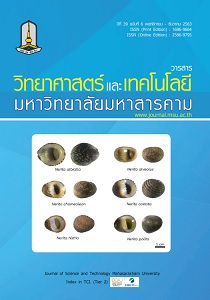The optimum filling ratio of water for a micro thermosyphon boiler
Main Article Content
Abstract
The optimum filling ratio of the working fluid is an important parameter for the heat transfer performance of hermosyphon, especially the new type of equipment. This experimental aim to study the filling ratio of water as a working fluid of a heat exchanger with a closed-boiler system using the principles of thermosyphon. The boiler as an evaporator with a volume of approximately 95% of the system. Experiment with constant heat flux of 50, 75 and 100 kW/m2. The filling ratio of water is in the range of 5-12% of the system volume. Condenser cooling with constant inlet temperature and mass flow rate of cold water. The results showed that the filling ratio of water as a working fluid of 7% is suitable for a micro thermosyphon boiler. Total thermal resistance was lowest when the heat flux is 100 kW/m2 of 0.062 ◦C/W while still tending to decrease as the heat flux increases.
Article Details
References
2. Grooten, M.H.M. and Geld, C.W.M. Predicting heat transfer in long, r-134a filled hermosyphons. ASME Journal of Heat Transfer. 2009; 131: 1-9.
3. Gorecki, G.Investigation of two-phase thermosyphon performance filled with modern HFC refrigerants. Heat and Mass Transfer. 2018; 54: 2131–2143.
4. Sukchana, T. and Thadniam, V. Effect of position of evaporator and condenser on heat transfer performance of r-134a loop thermosyphon. UBU Engineering Journal. 2019; 12 (1): 25–33. (In Thai).
5. Sukchana, T. Heat Transfer Performance of a Single-Pipe Thermosyphon with adiabatic length of 7.5le employing environmentally friendly refrigerant as a working fluid. KMUTT Research and Development Journal. 2019; 42 (4): 345–388. (In Thai).
6. Sukchana, T.Study of heat transfer performance of a loop thermosyphon using an environment-friendly refrigerants as a working fluid. The Journal of KMUTNB. 2020; 30 (2): 199–208. (In Thai).
7. Aghel, B., Rahimi, M., and Almasi, S. Heat transfer enhancement of two‑phase closed thermosyphon using a novel cross‑flow condenser. Heat Mass Transfer. 2017; 53: 765–773.
8. Jafari,D., Marco, P.Di., Filippeschi, S., Franco, A. An experimental investigation on the evaporation and condensation heat transfer of two-phase closed thermosyphons. Experimental Thermal and Fluid Science. 2017; 88: 111–123.
9. Lataoui, Z.,Jemni, A. Experimental investigation of a stainless steel two-phase closed thermosyphon. Applied Thermal Engineering. 2017; 121: 721–727.
10. Naresh,Y., Balaji, C. Experimental investigations of heat transfer from an internally finned two phase closed thermosyphon. Applied Thermal Engineering. 2017; 112: 1658–1666.
11. Kima, Y., Shina, D.H., Kima, J.S., Youb, S.M., Leea, J. Boiling and condensation heat transfer of inclined two-phase closed thermosyphon with various filling ratios. Applied Thermal Engineering.2018; 145: 328–342.
12. Sukchana, T. Design, construction and testing of a horizontal thermosyphon boiler. KMUTT Research and Development Journal. 2020; 43 (1): 67–78. (In Thai).
13. Sukchana, T., and Pratinthong, N. Effect of bending position on heat transfer performance of R-134a two-phase close loop thermosyphon with an adiabatic section using flexible hoses. International Journal of Heat and Mass Transfer. 2017; 114: 527–535.
14. Taylor, J.R. An introduction to error analysis: The study of uncertainties in physical measurements; University Sci. Book; 1997.


